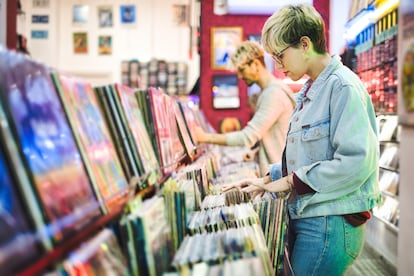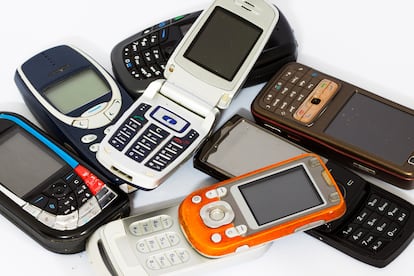Modern nostalgia: Why do young people ache for a past they never lived?
Social media idealization, the before and after marked by the pandemic and the belief that their parents’ lives were better are some of the reasons that drive the new generations to long for the olden days, even if they were not there

Common knowledge dictates that nostalgia is for mature people; the longer you live, the more memories you have to cherish, the farther you are from those happy, carefree days. However, the distance between nostalgia and youth is getting shorter and shorter. “The nostalgia of childhood, of thinking how beautiful everything was when we went to school and we had no problems or responsibilities, has always existed. But there is a new, specific nostalgia among the new generations,” points out psychologist Enrique García from the Official College of Psychologists of Madrid, in Spain. “It happens to all of us, but it happens more to older people because they have more experiences in the past,” confirms Roger Ballescà, vice-secretary of the Official College of Psychologists of Catalonia. Why, then, are those who have practically their entire lives ahead of them feeling nostalgic?
The etymological origin of the word defines it as the painful return to a past in which we were happy. However, even if it is painful, nostalgia serves as a form of transition, explains Olivia Szinetar, health psychologist and founding partner of the Sens Psychological Care Center, in Madrid. “What is lost is retained through memories, idealized memories, until, little by little, the adaptation stage arrives,” she says. However, social networks like Instagram or TikTok have made it difficult to cross this bridge. “The most recent generations (millennials and zoomers) have a more present past, an excess of photos and memories that obstruct the experience of loss. We are in the age of immediacy; everything is one click away. Nostalgia has become a resistance to accepting loss. Those who live in nostalgia resist reality,” she continues.

Today, memories are much more reachable and much more visually concrete. The downside is that they only show one side of the coin. “Images on social networks are usually of positive, special or important moments. If you go on a trip, you take your picture under a palm tree with a gin and tonic in your hand; not when you realize that the hotel bathtub is clogged,” reflects Ballescà, who is also coordinator of the child and youth mental health area of the Sagrat Cor Hospital in Martorell, Barcelona. “Nostalgia is based a lot on the fact that our memory of what happened is a little distorted. We tend to remember the good times better and idealize our past.”
Before being interviewed for this article, he had not noticed an increase in this feeling among the new generations. After reflecting on it, however, he can think of several reasons that explain it. One is the Covid-19 pandemic, which caught the youngest people right in the middle of their emotional, intellectual, social and sexual development. “It is a very clear breaking point between the way we used to function before and now. That can foster this feeling, because we have a point from which to go back. It is like before and after Christ; now we have before and after the pandemic. It specifies a moment in the past from which things change, and a greater tendency to feel nostalgia for the previous life may emerge, because we can visualize it more clearly.”

But young people have not only begun to wistfully recall their recent past. That series that they saw the summer of their first kiss, the band that played the first time they went to a festival with their friends or the dish they tried when they went backpacking. They also miss a past they never experienced. Spotify’s annual global trend report revealed in 2022 that Gen Z has a particular fondness for the 1980s and sees pop culture memories as a way to relieve their stress. “Faced with climate change, economic upheaval, and the threat of WWIII, [...] nostalgia has been shown to provide a sense of comfort amid uncertainty,” states the study. “However, while millennials are nostalgic for earlier eras they themselves lived through, Zs will latch on to almost any era that offers a reprieve from the heaviness of the now.”
For García, this is due to the widespread belief that while all generations have had, in principle, a better life than their parents, the current one is probably doing worse due to job insecurity, exorbitant housing prices and the lack of enthusiasm to start a family that comes with all this, among many other reasons. “Our previous models told us about wars, dictatorship and hunger, and we had no nostalgia for that. On the other hand, young people today think that their parents had a better life than them, with more freedom, more security and fewer problems, and that discourages them for the future. It is a restorative nostalgia instead of a reflective one, that is, it tries to restore that golden age,” explains the psychologist.

And like almost everything that young people touch, this longing for the bygone days that they never experienced has become a trend that has made vintage clothing, vinyl records, analog cameras and even the so-called dumbphones fashionable. This is how Nokia Phones’ marketing director Lars Silberbauer explained to Euronews Next in June the 5% increase that the company has seen in the flip phone market this year: “The past becomes reminiscent of a time when life seemed simpler and more carefree, and this yearning for the past has also driven the rise of the dumbphone trend. People want to go back to the early 2000s or the 1990s. I think that’s a remembrance of a happier time, a time where things were a bit simpler.”
With hastags like #y2kaesthetic or simply #nostalgia, social networks are full of low-rise pants, group photos of sneakers forming a star and corduroy tracksuits. “Memories of the past are more accessible; who doesn’t have immediate access to thousands of pictures on their phone? But perhaps the past is also more ephemeral,” Szinetar reflects. “We can access consumer objects and large amounts of information. The times require us to respond to demands quickly and change is a constant. And in this context, I wonder; is there room for nostalgia? Is there time to remember?” If you must remember something, let it be that time flies, and it is better to invest it in living experiences instead of evoking them.
Sign up for our weekly newsletter to get more English-language news coverage from EL PAÍS USA Edition
Tu suscripción se está usando en otro dispositivo
¿Quieres añadir otro usuario a tu suscripción?
Si continúas leyendo en este dispositivo, no se podrá leer en el otro.
FlechaTu suscripción se está usando en otro dispositivo y solo puedes acceder a EL PAÍS desde un dispositivo a la vez.
Si quieres compartir tu cuenta, cambia tu suscripción a la modalidad Premium, así podrás añadir otro usuario. Cada uno accederá con su propia cuenta de email, lo que os permitirá personalizar vuestra experiencia en EL PAÍS.
¿Tienes una suscripción de empresa? Accede aquí para contratar más cuentas.
En el caso de no saber quién está usando tu cuenta, te recomendamos cambiar tu contraseña aquí.
Si decides continuar compartiendo tu cuenta, este mensaje se mostrará en tu dispositivo y en el de la otra persona que está usando tu cuenta de forma indefinida, afectando a tu experiencia de lectura. Puedes consultar aquí los términos y condiciones de la suscripción digital.
More information
Últimas noticias
Alain Aspect, Nobel laureate in physics: ‘Einstein was so smart that he would have had to recognize quantum entanglement’
Imelda Castro, the woman who wants to rule the cartel battleground of Sinaloa
The new victims of the Republican war on Obamacare: Millions hit by soaring health insurance premiums
A country divided on migrant rights: Some US states expand protections while others restrict them
Most viewed
- David King, chemist: ‘There are scientists studying how to cool the planet; nobody should stop these experiments from happening’
- Reinhard Genzel, Nobel laureate in physics: ‘One-minute videos will never give you the truth’
- Oona Chaplin: ‘I told James Cameron that I was living in a treehouse and starting a permaculture project with a friend’
- Sinaloa Cartel war is taking its toll on Los Chapitos
- Mexico completes its trade shift with the entry into force of tariffs on China and countries without trade agreements











































